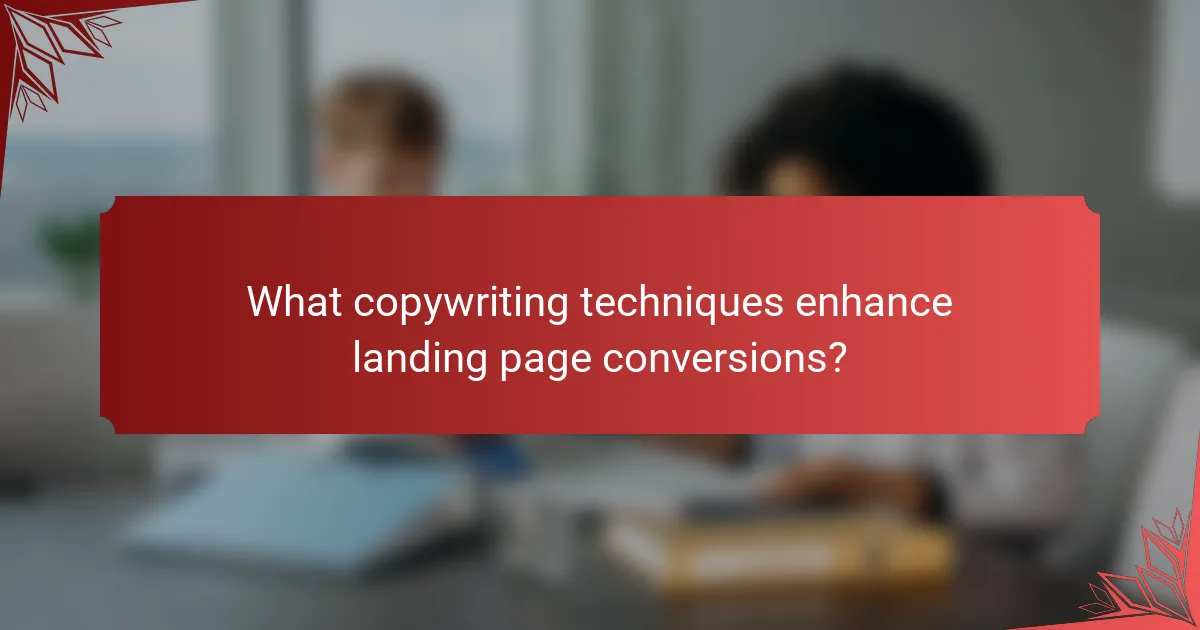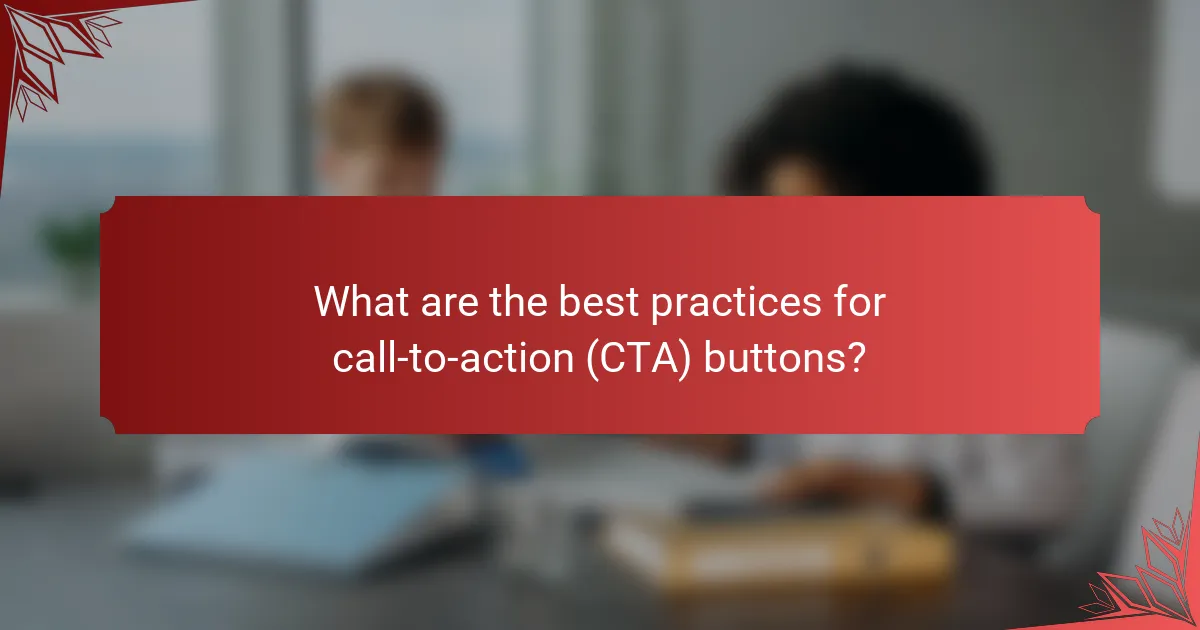Creating a high-converting landing page requires a strategic blend of design, compelling copy, and effective call-to-action elements. By prioritizing clarity, user experience, and trust signals, you can engage visitors and encourage them to take action. Implementing persuasive language and clear value propositions will further enhance your page’s effectiveness, driving higher conversion rates.

How to design a high-converting landing page?
To design a high-converting landing page, focus on clarity, user experience, and persuasive elements. Key components include a strong visual hierarchy, responsive design, effective use of color, and trust signals that build credibility.
Visual hierarchy principles
Visual hierarchy guides users’ attention to the most important elements on your landing page. Use size, color, and placement to emphasize headlines, calls to action (CTAs), and key information. For example, larger fonts for headings and contrasting colors for buttons can draw the eye effectively.
Consider the flow of information; arrange content in a way that naturally leads the user through the page. Group related items together and use bullet points for clarity, making it easier for visitors to scan and absorb your message.
Responsive design techniques
Responsive design ensures your landing page looks good on all devices, from desktops to smartphones. Use flexible grids and layouts that adapt to different screen sizes, ensuring that text and images resize appropriately.
Test your landing page on various devices and browsers to confirm that all elements function correctly. Tools like Google’s Mobile-Friendly Test can help identify issues and improve user experience across platforms.
Color psychology in design
Color psychology plays a crucial role in influencing user emotions and actions. Choose colors that align with your brand and evoke the desired response; for example, blue often conveys trust, while red can create urgency.
Limit your color palette to a few complementary colors to maintain visual coherence. Use contrasting colors for CTAs to make them stand out, ensuring they capture attention and encourage clicks.
Effective use of whitespace
Whitespace, or negative space, enhances readability and focus on your landing page. By providing ample space around text and images, you can reduce clutter and help users concentrate on key messages.
Aim for a balanced layout that avoids overwhelming visitors. Use whitespace strategically to separate sections and highlight important elements, making the page feel more inviting and easier to navigate.
Mobile optimization strategies
Mobile optimization is essential for capturing users on smartphones and tablets. Ensure that your landing page loads quickly, ideally within a few seconds, to prevent high bounce rates.
Utilize touch-friendly buttons and ensure that forms are easy to fill out on smaller screens. Keep content concise and prioritize essential information to enhance user experience on mobile devices.

What copywriting techniques enhance landing page conversions?
Effective copywriting techniques can significantly boost landing page conversions by engaging visitors and guiding them toward taking action. Key strategies include focusing on benefits, using persuasive language, incorporating storytelling elements, and presenting clear value propositions.
Benefits-focused messaging
Benefits-focused messaging highlights how a product or service solves a problem or improves the user’s life. Instead of merely listing features, emphasize the outcomes that users can expect, such as saving time or increasing productivity.
For instance, instead of saying “Our software has advanced analytics,” you could say, “Unlock insights that help you make data-driven decisions in minutes.” This approach resonates more with potential customers.
Use of persuasive language
Persuasive language involves using words and phrases that evoke emotions and encourage action. Strong verbs, vivid adjectives, and compelling calls to action can create a sense of urgency or excitement.
Words like “exclusive,” “limited-time,” and “guaranteed” can enhance the appeal of your offer. For example, “Join our exclusive community today and start your journey to success!” can motivate users to act quickly.
Storytelling elements
Incorporating storytelling elements can make your landing page more relatable and memorable. Sharing a brief narrative about how your product helped a real customer can create an emotional connection.
For example, a testimonial that describes a user’s journey from struggle to success can illustrate the value of your offering. This narrative approach helps potential customers envision themselves achieving similar results.
Clear value propositions
A clear value proposition succinctly communicates the unique benefits of your product or service. It should answer the question, “Why should I choose you?” in a way that is easy to understand.
Use concise statements to outline what sets you apart from competitors. For example, “Get 24/7 support and a money-back guarantee, ensuring your satisfaction.” This clarity can significantly influence a visitor’s decision-making process.

What are the best practices for call-to-action (CTA) buttons?
The best practices for call-to-action (CTA) buttons focus on visibility, clarity, and urgency. A well-placed and effectively worded CTA can significantly increase conversion rates by guiding users toward the desired action.
CTA placement strategies
Positioning your CTA buttons strategically is crucial for maximizing visibility and engagement. Common placements include above the fold, at the end of content, or as a sticky element that follows the user as they scroll. Testing different placements can help determine what works best for your audience.
Consider using multiple CTAs throughout your landing page to cater to different user intents. For example, a primary CTA can be placed prominently, while secondary CTAs can offer alternative actions, such as signing up for a newsletter or downloading a resource.
Effective CTA wording
The wording of your CTA should be clear, compelling, and action-oriented. Use strong verbs that convey urgency, such as “Get Started,” “Sign Up Now,” or “Claim Your Offer.” Avoid vague phrases that do not clearly communicate the action you want users to take.
Additionally, personalizing the CTA can enhance its effectiveness. For instance, instead of a generic “Download,” consider “Download Your Free Guide” to make it more appealing. Tailoring the language to resonate with your target audience can lead to higher conversion rates.
Design elements that attract clicks
The design of your CTA button plays a significant role in its effectiveness. Use contrasting colors that stand out from the rest of the page to draw attention. Ensure the button is large enough to be easily clickable, especially on mobile devices.
Incorporating visual cues, such as arrows or icons, can also guide users’ eyes toward the CTA. Additionally, consider using rounded corners or shadows to create a button that feels clickable and inviting. Testing different designs can help you find the most effective combination for your audience.

How to incorporate trust signals on landing pages?
Incorporating trust signals on landing pages is essential for building credibility and encouraging conversions. These elements reassure visitors that your brand is reliable and that their personal information is secure.
Customer testimonials and reviews
Customer testimonials and reviews serve as powerful trust signals by showcasing real experiences from satisfied clients. Including quotes from customers can humanize your brand and provide social proof that your product or service delivers results.
Consider displaying a mix of short testimonials and detailed reviews, ideally with names and photos for authenticity. Aim for a few standout testimonials that highlight specific benefits, as well as a broader collection of reviews to cover various aspects of your offering.
Security badges and certifications
Security badges and certifications are critical for reassuring visitors about the safety of their data. Displaying recognized security symbols, such as SSL certificates or payment processor logos, can significantly reduce anxiety regarding online transactions.
Ensure these badges are prominently placed, ideally near your call-to-action (CTA). Use only well-known certifications that are relevant to your industry, as this will enhance credibility and trustworthiness.
Case studies and success stories
Case studies and success stories provide in-depth insights into how your product or service has positively impacted customers. These narratives can illustrate the problem, solution, and results, making them compelling trust signals.
When creating case studies, focus on specific metrics or outcomes that potential customers can relate to. Use clear, concise language and include visuals or charts to make the information more engaging. Aim for a few detailed case studies that highlight diverse use cases to appeal to a broader audience.

What metrics should be tracked for landing page performance?
To effectively gauge landing page performance, focus on key metrics such as conversion rate, bounce rate, and click-through rate. These metrics provide insights into user engagement, effectiveness of the design, and overall success in achieving your goals.
Conversion rate analysis
Conversion rate analysis measures the percentage of visitors who complete a desired action, such as signing up for a newsletter or making a purchase. A good conversion rate typically ranges from 2% to 5%, but this can vary significantly based on the industry and target audience.
To improve your conversion rate, consider A/B testing different elements like headlines, images, and calls to action. Regularly reviewing this metric helps identify trends and areas for enhancement, ensuring your landing page remains effective.
Bounce rate monitoring
Bounce rate monitoring tracks the percentage of visitors who leave your landing page without interacting further. A high bounce rate, often above 50%, can indicate that your content or design is not resonating with visitors.
To reduce bounce rates, ensure that your landing page loads quickly and provides clear, relevant information. Engaging visuals and compelling headlines can also help retain visitors and encourage them to explore further.
Click-through rate evaluation
Click-through rate (CTR) evaluation measures how often visitors click on links or calls to action compared to the total number of visitors. A healthy CTR typically falls between 1% and 3%, depending on the context and placement of the links.
To enhance your CTR, use strong, action-oriented language in your calls to action and ensure they are prominently placed on the page. Testing different formats, colors, and placements can reveal what resonates best with your audience, leading to improved engagement.

What tools can help optimize landing pages?
Several tools can significantly enhance the effectiveness of landing pages by improving design, copy, and user engagement. These tools help analyze user behavior, streamline design processes, and optimize conversion rates.
Analytics Tools
Analytics tools like Google Analytics and Hotjar provide insights into user behavior on landing pages. They track metrics such as bounce rates, time on page, and conversion rates, helping identify areas for improvement.
Utilizing heatmaps and session recordings can reveal how users interact with your landing page. This data allows you to make informed decisions about layout changes, content adjustments, and call-to-action placements.
A/B Testing Software
A/B testing software, such as Optimizely or VWO, enables you to compare different versions of your landing page. By testing variations in headlines, images, and CTAs, you can determine which elements drive higher conversion rates.
Implementing A/B tests helps minimize guesswork in design and copy decisions. Aim for a sample size that provides statistically significant results, typically in the low hundreds to thousands of visitors.
Landing Page Builders
Landing page builders like Unbounce and Leadpages simplify the creation of high-converting pages without extensive coding knowledge. These platforms offer customizable templates and drag-and-drop features, making it easy to design visually appealing pages.
When choosing a builder, consider factors like integration with email marketing tools and CRM systems. Look for options that allow for easy testing and optimization to ensure your landing pages remain effective over time.
SEO Tools
SEO tools such as SEMrush and Moz help optimize landing pages for search engines. They provide keyword analysis, on-page SEO recommendations, and competitor insights to enhance visibility and attract organic traffic.
Incorporating relevant keywords naturally into your landing page copy can improve search rankings. Regularly updating content based on SEO insights ensures your pages stay relevant and competitive.
Trust Signal Tools
Trust signal tools, including Trustpilot and Yotpo, help build credibility on landing pages. Displaying customer reviews, ratings, and testimonials can significantly enhance user trust and encourage conversions.
Consider integrating trust badges and security certifications to reassure visitors about data protection. Highlighting positive customer experiences can effectively sway potential customers towards making a purchase.
